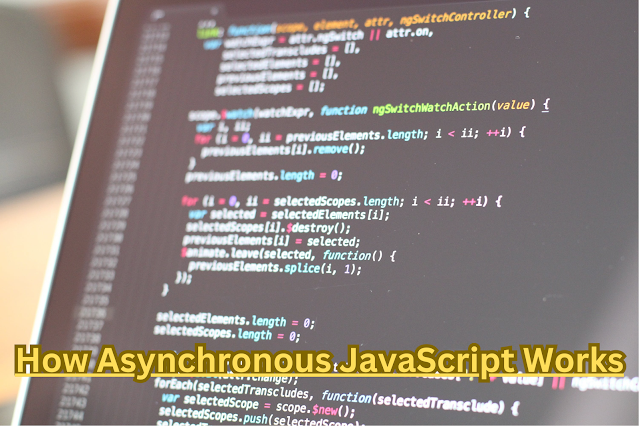Table of Contents
What is Asynchronous JavaScript?
Asynchronous JavaScript refers to the execution of JavaScript code in a non-blocking manner, allowing other tasks to run concurrently. It enables the browser or runtime environment to continue executing code while waiting for certain operations to complete, such as fetching data from a server, reading/writing files, or waiting for user input.In synchronous programming, each line of code is executed one after the other, and the program waits for each operation to complete before moving on to the next one. This can lead to blocking behavior, where the program becomes unresponsive until a task finishes.
Asynchronous programming, on the other hand, allows multiple tasks to be initiated and run in the background simultaneously, without blocking the execution of subsequent code. It makes use of callbacks, promises, and async/await to handle the completion or failure of asynchronous operations.
Here's an example to illustrate asynchronous JavaScript using the setTimeout function:
Javascript
console.log('Start');
setTimeout(function() {
console.log('Asynchronous operation');
}, 2000);
console.log('End');
In this example, the code starts by printing 'Start' to the console. Then, the setTimeout function is called, which schedules the execution of the provided function after a specified delay (in this case, 2000 milliseconds or 2 seconds). However, instead of waiting for the delay to complete, the program immediately moves on to the next line.
So, 'End' is printed to the console while the delay is still running. After 2 seconds, the function inside setTimeout (the asynchronous operation) is executed, and 'Asynchronous operation' is printed to the console.
The key point to note here is that the delay doesn't block the execution of the subsequent code. Asynchronous operations allow the program to continue with other tasks while waiting for the completion of time-consuming operations or external events.
Example to illustrate asynchronous JavaScript using Ajax Requests:
Javascript
console.log('Start');
// Making an asynchronous HTTP GET request
const xhr = new XMLHttpRequest();
xhr.open('GET', 'https://api.example.com/data', true);
xhr.onload = function() {
if (xhr.status === 200) {
console.log(xhr.responseText);
}
};
xhr.send();
console.log('End');
Example to illustrate asynchronous JavaScript using Promises:
Javascript
console.log('Start');
// Example of a promise-based asynchronous operation
const fetchData = new Promise(function(resolve, reject) {
setTimeout(function() {
const data = 'Async data';
resolve(data);
}, 2000);
});
fetchData.then(function(data) {
console.log(data);
});
console.log('End');
In this example, a Promise is created to represent an asynchronous operation that resolves after a delay of 2 seconds. The fetchData promise is resolved with the data 'Async data'. The then method is used to handle the resolved value and log it to the console.
Example to illustrate asynchronous JavaScript using Event handling:
Javascript
console.log('Start');
// Asynchronous event handling
document.addEventListener('click', function() {
console.log('Click event occurred');
});
console.log('End');In this example, an event listener is attached to the click event of the document. When a click event occurs, the callback function is executed asynchronously, printing 'Click event occurred' to the console. The program continues to execute the subsequent code without blocking.
These examples demonstrate different use cases for asynchronous JavaScript, such as making HTTP requests, using promises for asynchronous operations, and handling events asynchronously. Asynchronous programming allows JavaScript applications to be more responsive and efficient by avoiding blocking behavior and enabling concurrent execution of tasks.
Asynchronous JavaScript allows for concurrent execution, enhances responsiveness, and is particularly useful for handling events and I/O operations. It relies on callbacks, promises, and async/await to manage the completion or failure of asynchronous tasks. On the other hand, synchronous JavaScript executes code sequentially and blocks the program until each task completes. It is typically used for regular function calls and operations that don't require concurrent execution or event handling.
Both synchronous and asynchronous JavaScript have their use cases, and the choice between them depends on the specific requirements of the application.
These examples demonstrate different use cases for asynchronous JavaScript, such as making HTTP requests, using promises for asynchronous operations, and handling events asynchronously. Asynchronous programming allows JavaScript applications to be more responsive and efficient by avoiding blocking behavior and enabling concurrent execution of tasks.
Asynchronous vs synchronous
| Asynchronous JavaScript | Synchronous JavaScript | |
|---|---|---|
| Execution Behavior | Executes code non-blocking, allowing other tasks to run concurrently | Executes code in a blocking manner, one line at a time |
| Task Handling | Initiates tasks and continues execution without waiting for results | Waits for each task to complete before moving to the next one |
| Responsiveness | Enhances responsiveness, preventing the program from becoming unresponsive during long-running tasks | May cause the program to become unresponsive during long-running tasks |
| Concurrency | Supports concurrent execution, allowing multiple tasks to run simultaneously | Executes tasks sequentially, one after the other |
| Event-driven | Well-suited for handling events, I/O operations, and asynchronous operations such as AJAX requests and timers | Not inherently designed for event-driven or I/O operations |
| Callbacks/Handlers | Relies on callbacks, event handlers, promises, or async/await syntax to handle the completion or failure of asynchronous tasks | Executes code in a linear fashion, without specialized constructs for asynchronous operations |
| Delayed Execution | Utilizes techniques like setTimeout or setInterval to schedule code execution after a specified delay | Doesn't provide built-in mechanisms for delayed execution |
| Error Handling | Requires explicit error handling through callback functions, error events, or promise rejection handlers | Exceptions can be caught using try-catch blocks or error event handlers |
| Examples | AJAX requests, setTimeout, setInterval, event handling, Promises, async/await | Regular function calls, loops, synchronous file operations |
Both synchronous and asynchronous JavaScript have their use cases, and the choice between them depends on the specific requirements of the application.







0 Comments